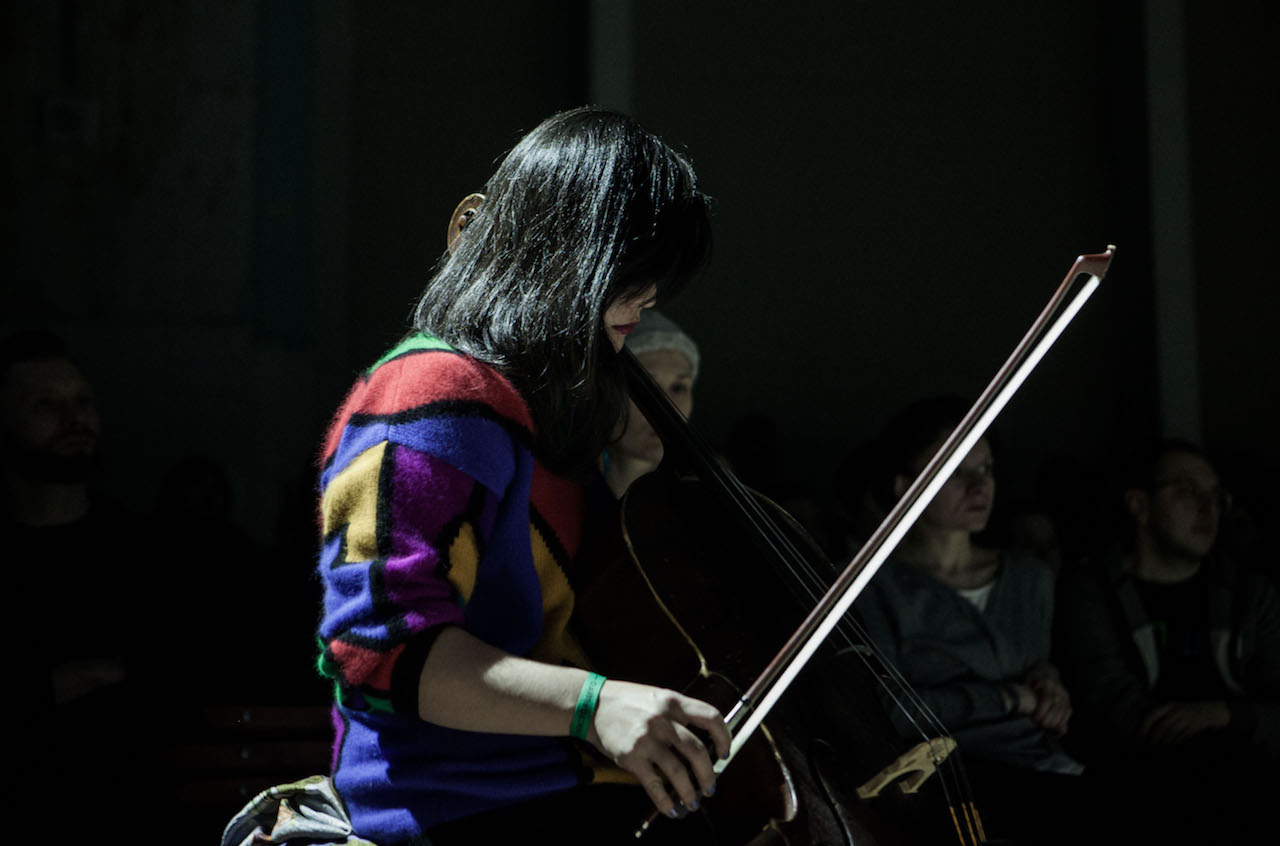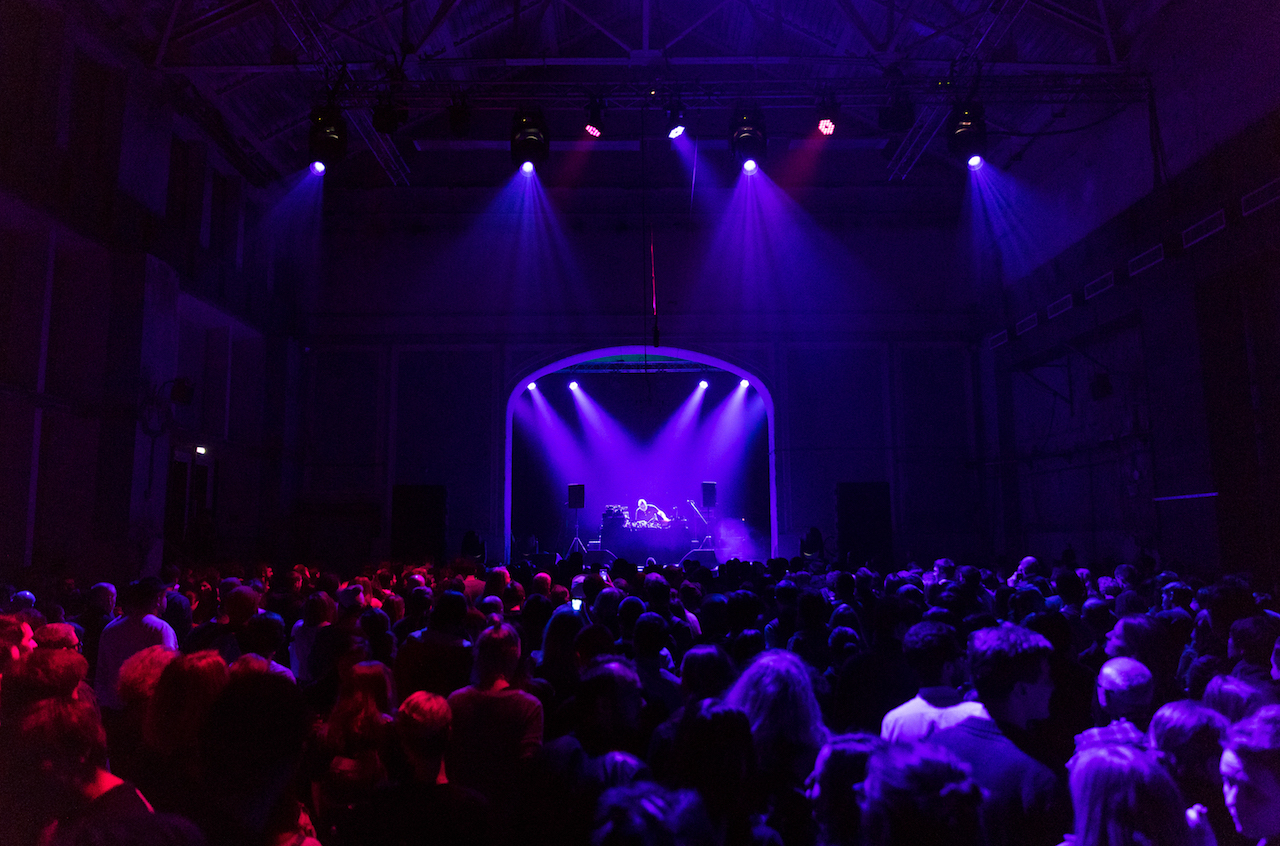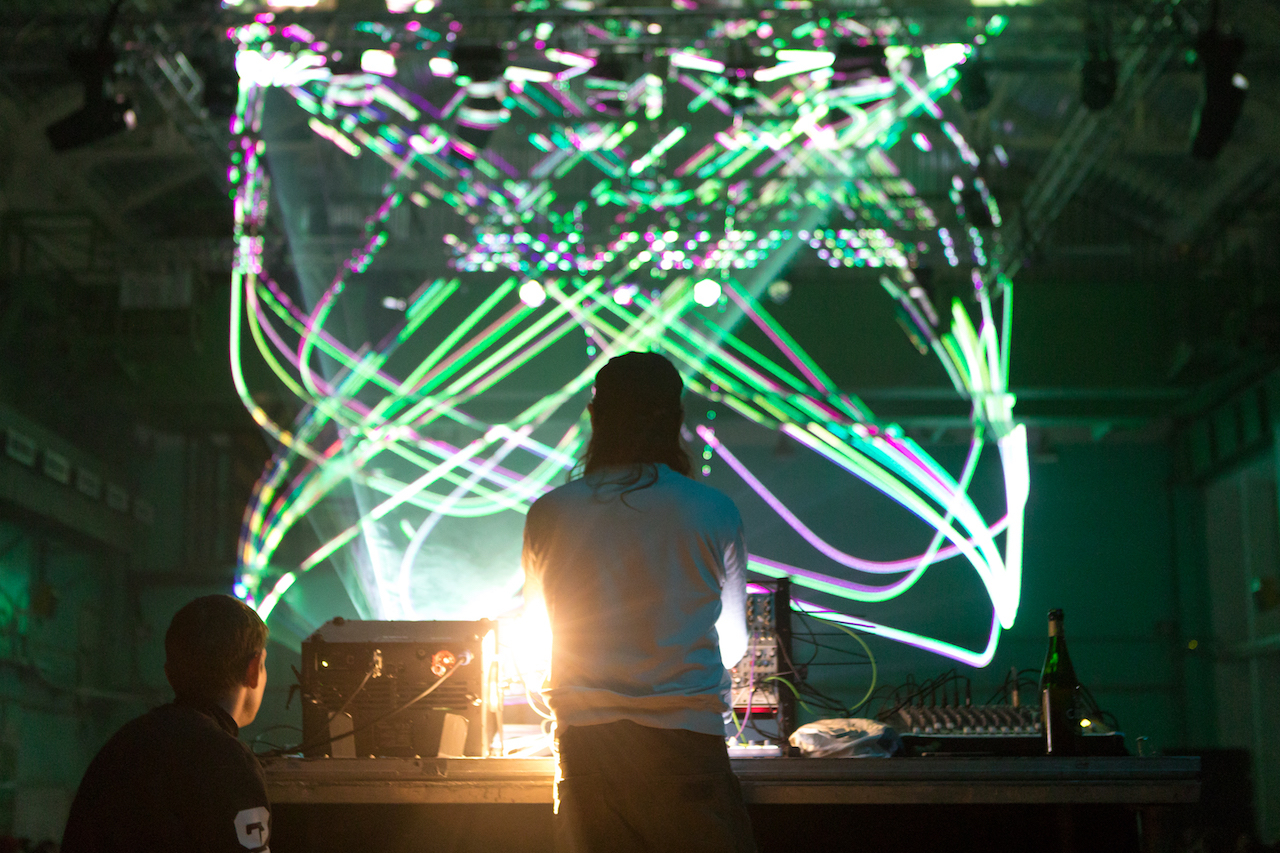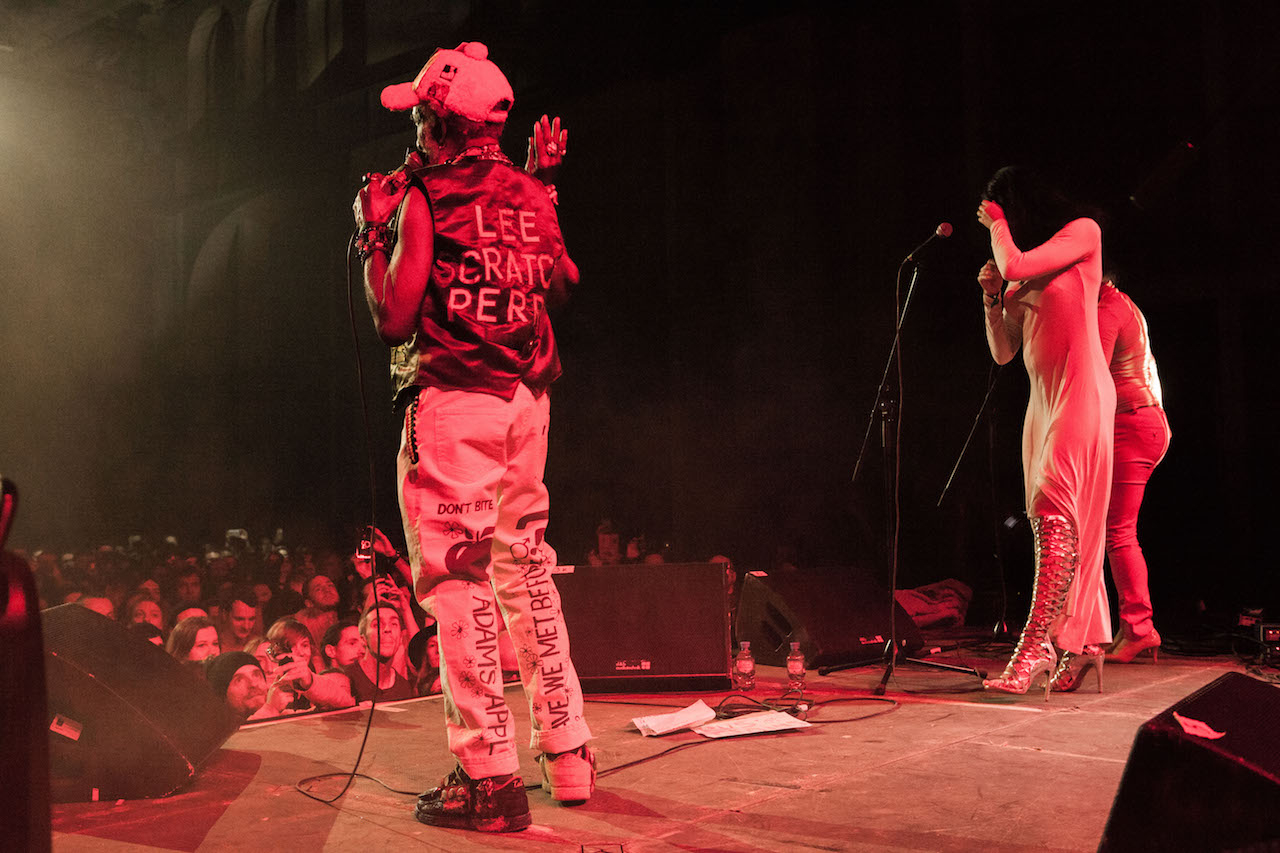- For a certain kind of electronic music fan, Mark Fell is a hero. The uncompromising post-rave experimentalist has built a devoted following over the years, first for his work alongside Mat Steel as SND, then during his subsequent solo career, and, more recently, for his sound-related art installations. So it was thrilling when news broke that Fell had curated an entire festival—a week-long event encompassing performances, installations and talks—produced by V-A-C Foundation, the Moscow-based non-profit art initiative owned by Russia's wealthiest man, Leonid Mikhelson. Geometry Of Now came about largely thanks to V-A-C's plans for GES-2, a former power station located a stone's throw from the Kremlin in Moscow's Red October district. The venue, a huge complex that's set to become both a center for contemporary art and the foundation's headquarters, was only midway through renovation when the festival started. A shell gutted of its former contents, it provided a one-time opportunity to enjoy music and art against a backdrop of raw, post-industrial chic.
With a first-class soundsystem that suited early evening experimental concerts as much as late-night DJ sets, and only one room for performances (outside of the opening concert), the festival's production team cleverly designed two different speaker setups. The first made the center of the room the stage, with benches set along each side. This was how I experienced Raster-Noton artist CoH's meditative set, punctuated with booming bass and clicks. Or observed as Alexander Kislov—a dancer in blue face paint and silk boxer shorts—writhed to Okkyung Lee's bending cello swoops and Oren Ambarchi's manipulated feedback responses.
The second setup pushed the speakers out to the corners and incorporated a stage built into a smaller adjoining room, increasing capacity and opening up space to dance. This was where the nighttime sessions went down from Thursday through Saturday, starting with experimental music before moving gradually through the intersection of experimental and dance music towards a final stretch of more straight-ahead club sounds, wrapping up at 6 AM. On Thursday, Thomas Brinkmann's arrhythmic dub veered into noise textures and pounding kicks. Ripatti's percussive fluidity moved effortlessly between styles and dynamics, layering footwork-y elements with dreamy house synths, drum & bass-style basslines and ravey stabs. Equiknoxx, who were playing live for only the third time, stitched together dubby, booty-shaking bashment, dancehall and dubstep in new and unexpected ways. Errorsmith is an expert of intense acid build-ups and gradual breakdowns, and he played techno full of funky house beats and African-inspired rhythms. His set felt offbeat and inventive, with a dash of humor. Due to the advancement of multiple sclerosis, Anthony "Shake" Shakir is no longer so deft in the mix, but the Detroit veteran has an enviable record collection and remains an incredible selector. He closed Thursday night with a set of killer house.
Friday night had a similarly nice flow to it. Russell Haswell revved up the crowd and left them smiling with his skilful and entertaining approach to noise, matching punk sonics to sound-responsive lasers. UK producer Rian Treanor sounded closest to Fell himself, which is maybe not surprising given that he's his son. That said, Treanor tends to aim more squarely at the dance floor, and his elastic funk featured sections that sat somewhere between trance, bleep and footwork. It provided the perfect warm-up for RP Boo's DJ set, which, soulful as ever, inspired the most frenzied dancing of the weekend thanks to a particularly irresistible passage of ghettotech and juke. Jlin's tracks can shift from martial heaviness to the most dexterous rhythm programming, which is probably why both Fell and Errorsmith cited hers as one of their favorite sets. DJ Sprinkles closed with a performance that felt equal parts mournful and euphoric, drawing largely from her classic Midtown 120 Blues album.
The crowd ballooned in size on Saturday night, but the rhythms grew more gentle. Guitar wizard Ambarchi and regular drummer Will Guthrie had the crowd in a trance with their hypnotic brand of desert blues. Modular master Keith Fullerton Whitman made good use of the system's spatialized sound, though his set, full of sci-fi bleeps and wafting drones, felt too brief. Adrian Sherwood's, meanwhile, felt too familiar, his feel-good roots records and dubby FX sounding at odds with the weekend's otherwise modern programming.
Many of the musicians were old friends of Fell's, which raised the median age of the performers considerably. The artists, on the other hand, were mostly much younger, presenting engrossing site-specific installations. Presto!? affiliate Theo Burt's euphoric rave fragments reverberated around the building's biggest room via separated and distributed PA components. The music would have been fantastic on its own, but in situ the scale was immense. When the house lights came on, it was as if a stop-motion rave had taken place over the course of the night.
It was interesting that, aside from CoH and Inga Copeland, both of whom have incidentally not lived in Russia for more than 20 years, all of the domestic musicians fell loosely into the experimental category. Maybe this was due to the affiliations of the festival partner, an arts organization—rather than a music promoter—with a mission devoted to Russian contemporary art. Or it could have something to do with Russia's electronic scene, which seems more focussed on club-ready beats. Either way, the performances I saw by Russian artists—including synth bank quartet Kurvenschreiber and laptop duo Alexei Borisov and Sergey Kasich—were as proficient as anything you might see in similar Western scenes, even if nothing felt particularly distinctive.
Perhaps the most thoughtful statement on Russian-ness was Fell's decision to hang Vasily Kandinsky's 1932 painting Krass und Mild, made while the artist was studying at Bauhaus in Germany and living in fear of being discovered by the Gestapo. Now worth more than $10 million, it hung in a tiny workers' breakroom accidentally preserved, including cigarette butts and an ashtray, from decades ago. Its exhibition in such a setting called to mind Fell's own working-class background in the Northern English town of Rotherham, while offering a sly nod to the surveillance state. A sublime work of angular geometry, rhythm and color, Krass und Mild also feels timelessly modern. It speaks directly to Fell's own practice, as well as his curatorial leanings, and it closed the circle of Geometry Of Now, a beautifully composed interchange of high art, underground internationalism and sensual pleasure.
Photo credit /
Robin Roger - Lead, Okkyung Lee, Lee "Scratch" Perry
Ivan Erofeev - Adrian Sherwood, Russell Haswell
 The second setup pushed the speakers out to the corners and incorporated a stage built into a smaller adjoining room, increasing capacity and opening up space to dance. This was where the nighttime sessions went down from Thursday through Saturday, starting with experimental music before moving gradually through the intersection of experimental and dance music towards a final stretch of more straight-ahead club sounds, wrapping up at 6 AM. On Thursday, Thomas Brinkmann's arrhythmic dub veered into noise textures and pounding kicks. Ripatti's percussive fluidity moved effortlessly between styles and dynamics, layering footwork-y elements with dreamy house synths, drum & bass-style basslines and ravey stabs. Equiknoxx, who were playing live for only the third time, stitched together dubby, booty-shaking bashment, dancehall and dubstep in new and unexpected ways. Errorsmith is an expert of intense acid build-ups and gradual breakdowns, and he played techno full of funky house beats and African-inspired rhythms. His set felt offbeat and inventive, with a dash of humor. Due to the advancement of multiple sclerosis, Anthony "Shake" Shakir is no longer so deft in the mix, but the Detroit veteran has an enviable record collection and remains an incredible selector. He closed Thursday night with a set of killer house. Friday night had a similarly nice flow to it. Russell Haswell revved up the crowd and left them smiling with his skilful and entertaining approach to noise, matching punk sonics to sound-responsive lasers. UK producer Rian Treanor sounded closest to Fell himself, which is maybe not surprising given that he's his son. That said, Treanor tends to aim more squarely at the dance floor, and his elastic funk featured sections that sat somewhere between trance, bleep and footwork. It provided the perfect warm-up for RP Boo's DJ set, which, soulful as ever, inspired the most frenzied dancing of the weekend thanks to a particularly irresistible passage of ghettotech and juke. Jlin's tracks can shift from martial heaviness to the most dexterous rhythm programming, which is probably why both Fell and Errorsmith cited hers as one of their favorite sets. DJ Sprinkles closed with a performance that felt equal parts mournful and euphoric, drawing largely from her classic Midtown 120 Blues album.
The second setup pushed the speakers out to the corners and incorporated a stage built into a smaller adjoining room, increasing capacity and opening up space to dance. This was where the nighttime sessions went down from Thursday through Saturday, starting with experimental music before moving gradually through the intersection of experimental and dance music towards a final stretch of more straight-ahead club sounds, wrapping up at 6 AM. On Thursday, Thomas Brinkmann's arrhythmic dub veered into noise textures and pounding kicks. Ripatti's percussive fluidity moved effortlessly between styles and dynamics, layering footwork-y elements with dreamy house synths, drum & bass-style basslines and ravey stabs. Equiknoxx, who were playing live for only the third time, stitched together dubby, booty-shaking bashment, dancehall and dubstep in new and unexpected ways. Errorsmith is an expert of intense acid build-ups and gradual breakdowns, and he played techno full of funky house beats and African-inspired rhythms. His set felt offbeat and inventive, with a dash of humor. Due to the advancement of multiple sclerosis, Anthony "Shake" Shakir is no longer so deft in the mix, but the Detroit veteran has an enviable record collection and remains an incredible selector. He closed Thursday night with a set of killer house. Friday night had a similarly nice flow to it. Russell Haswell revved up the crowd and left them smiling with his skilful and entertaining approach to noise, matching punk sonics to sound-responsive lasers. UK producer Rian Treanor sounded closest to Fell himself, which is maybe not surprising given that he's his son. That said, Treanor tends to aim more squarely at the dance floor, and his elastic funk featured sections that sat somewhere between trance, bleep and footwork. It provided the perfect warm-up for RP Boo's DJ set, which, soulful as ever, inspired the most frenzied dancing of the weekend thanks to a particularly irresistible passage of ghettotech and juke. Jlin's tracks can shift from martial heaviness to the most dexterous rhythm programming, which is probably why both Fell and Errorsmith cited hers as one of their favorite sets. DJ Sprinkles closed with a performance that felt equal parts mournful and euphoric, drawing largely from her classic Midtown 120 Blues album. The crowd ballooned in size on Saturday night, but the rhythms grew more gentle. Guitar wizard Ambarchi and regular drummer Will Guthrie had the crowd in a trance with their hypnotic brand of desert blues. Modular master Keith Fullerton Whitman made good use of the system's spatialized sound, though his set, full of sci-fi bleeps and wafting drones, felt too brief. Adrian Sherwood's, meanwhile, felt too familiar, his feel-good roots records and dubby FX sounding at odds with the weekend's otherwise modern programming. Many of the musicians were old friends of Fell's, which raised the median age of the performers considerably. The artists, on the other hand, were mostly much younger, presenting engrossing site-specific installations. Presto!? affiliate Theo Burt's euphoric rave fragments reverberated around the building's biggest room via separated and distributed PA components. The music would have been fantastic on its own, but in situ the scale was immense. When the house lights came on, it was as if a stop-motion rave had taken place over the course of the night.
The crowd ballooned in size on Saturday night, but the rhythms grew more gentle. Guitar wizard Ambarchi and regular drummer Will Guthrie had the crowd in a trance with their hypnotic brand of desert blues. Modular master Keith Fullerton Whitman made good use of the system's spatialized sound, though his set, full of sci-fi bleeps and wafting drones, felt too brief. Adrian Sherwood's, meanwhile, felt too familiar, his feel-good roots records and dubby FX sounding at odds with the weekend's otherwise modern programming. Many of the musicians were old friends of Fell's, which raised the median age of the performers considerably. The artists, on the other hand, were mostly much younger, presenting engrossing site-specific installations. Presto!? affiliate Theo Burt's euphoric rave fragments reverberated around the building's biggest room via separated and distributed PA components. The music would have been fantastic on its own, but in situ the scale was immense. When the house lights came on, it was as if a stop-motion rave had taken place over the course of the night. It was interesting that, aside from CoH and Inga Copeland, both of whom have incidentally not lived in Russia for more than 20 years, all of the domestic musicians fell loosely into the experimental category. Maybe this was due to the affiliations of the festival partner, an arts organization—rather than a music promoter—with a mission devoted to Russian contemporary art. Or it could have something to do with Russia's electronic scene, which seems more focussed on club-ready beats. Either way, the performances I saw by Russian artists—including synth bank quartet Kurvenschreiber and laptop duo Alexei Borisov and Sergey Kasich—were as proficient as anything you might see in similar Western scenes, even if nothing felt particularly distinctive. Perhaps the most thoughtful statement on Russian-ness was Fell's decision to hang Vasily Kandinsky's 1932 painting Krass und Mild, made while the artist was studying at Bauhaus in Germany and living in fear of being discovered by the Gestapo. Now worth more than $10 million, it hung in a tiny workers' breakroom accidentally preserved, including cigarette butts and an ashtray, from decades ago. Its exhibition in such a setting called to mind Fell's own working-class background in the Northern English town of Rotherham, while offering a sly nod to the surveillance state. A sublime work of angular geometry, rhythm and color, Krass und Mild also feels timelessly modern. It speaks directly to Fell's own practice, as well as his curatorial leanings, and it closed the circle of Geometry Of Now, a beautifully composed interchange of high art, underground internationalism and sensual pleasure. Photo credit / Robin Roger - Lead, Okkyung Lee, Lee "Scratch" Perry Ivan Erofeev - Adrian Sherwood, Russell Haswell
It was interesting that, aside from CoH and Inga Copeland, both of whom have incidentally not lived in Russia for more than 20 years, all of the domestic musicians fell loosely into the experimental category. Maybe this was due to the affiliations of the festival partner, an arts organization—rather than a music promoter—with a mission devoted to Russian contemporary art. Or it could have something to do with Russia's electronic scene, which seems more focussed on club-ready beats. Either way, the performances I saw by Russian artists—including synth bank quartet Kurvenschreiber and laptop duo Alexei Borisov and Sergey Kasich—were as proficient as anything you might see in similar Western scenes, even if nothing felt particularly distinctive. Perhaps the most thoughtful statement on Russian-ness was Fell's decision to hang Vasily Kandinsky's 1932 painting Krass und Mild, made while the artist was studying at Bauhaus in Germany and living in fear of being discovered by the Gestapo. Now worth more than $10 million, it hung in a tiny workers' breakroom accidentally preserved, including cigarette butts and an ashtray, from decades ago. Its exhibition in such a setting called to mind Fell's own working-class background in the Northern English town of Rotherham, while offering a sly nod to the surveillance state. A sublime work of angular geometry, rhythm and color, Krass und Mild also feels timelessly modern. It speaks directly to Fell's own practice, as well as his curatorial leanings, and it closed the circle of Geometry Of Now, a beautifully composed interchange of high art, underground internationalism and sensual pleasure. Photo credit / Robin Roger - Lead, Okkyung Lee, Lee "Scratch" Perry Ivan Erofeev - Adrian Sherwood, Russell Haswell